SIAI-Marchetti SF.260
The SIAI-Marchetti SF.260 (now Leonardo SF-260)[4] is an Italian light aircraft which has been commonly marketed as a military trainer and aerobatics aircraft.
| SF.260 | |
|---|---|
.jpg) | |
| A SF.260 of the Libyan Air Force | |
| Role | Trainer/Light attack |
| Manufacturer | SIAI-Marchetti Aermacchi Alenia Aermacchi Leonardo S.p.A. |
| Designer | Stelio Frati |
| First flight | 15 July 1964 |
| Introduction | April 1966 (FAA certification)[1] |
| Status | In service |
| Primary users | Italian Air Force Turkish Air Force Mexican Air Force Philippine Air Force |
| Produced | 1964–present |
| Number built | 870+ (2005)[2] |
| Unit cost |
$185,000 (1984)[3] |
The SF.260 was designed by Italian aircraft designer Stelio Frati, while production work originally performed by Milan-based aviation manufacturer Aviamilano. On 15 July 1964, the first prototype performed its maiden flight (then designated F.260). Shortly thereafter, responsibility for production was transferred to SIAI Marchetti, who had purchased the rights to the design; manufacturing continued to be performed by this firm until the company was bought by Aermacchi in 1997.
The SF.260 has been largely sold to military customers as a trainer and light combat aircraft. In addition, there have been limited civil sales to private operators; during the late 1960s, the type was marketed in the United States under the name Waco Meteor. Armed military versions, sold as the SF.260W Warrior, proved to be popular with smaller air forces, which could arm the type for use in the close air support role. Both piston-powered and turboprop-powered models have been developed.
Development
Origins
During the early 1960s, Italian aircraft designer Stelio Frati commenced work upon a new three-seat aerobatic design, which was primarily intended to serve as a sport aircraft.[5] Unlike many of its peers of the era, it was developed to possess aerobatic capabilities akin to contemporary combat aircraft, as well as being equipped for instrument flight rules (IFR) flight.[3] This design drew heavily upon his previous projects, including the jet-powered Caproni Trento F-5 prototype trainer and the Sequoia Falco twin-seat aerobatic aircraft, sharing the same wing and a similar structure to the Falco.[6] The envisioned aircraft, initially designated as the F.250 due to the horse power of its engine, was Frati's first all-metal aircraft.[6]
On 15 July 1964, the type performed its maiden flight.[6] In the aftermath of the maiden flight, prime responsibility for the type's manufacture was acquired from Aviamilano by SIAI Marchetti, which had purchased the rights to the design outright. Shortly after entering production, the SF.260 found itself in high demand by military customers, who often adopted it interchangeably as a military trainer or as a lightweight ground-attack aircraft.[3] Between 1964 and 1984, the majority of customers for the type were military, while a small number of private pilots had been able to obtain a few, although supply in this respect was constrained.[3]
During the late 1960s, the aircraft was marketed in the United States market as the Waco Meteor, although it had no connections of any form with the Waco Aircraft Company; the venture was relatively unsuccessful.[7] During the late 1970s and 1980s, American airline pilot Frank Strickler became a major reseller of the type, being credited with re-launching civil sales of the SF.260 in the region, acquiring them from SIAI Marchetti in small batches and individually selling them on to US-based customers.[3]
Further development
During the late 1970s, an improved model of the SF.260A, designated as the SF.260C, had replaced it in production.[8] This model featured various improvements, including redesigned tabs on the ailerons, a strengthened wing, a re-profiled aerofoil for improved low-speed handling, and an elongated tail/rudder. The SF.260C was designed for compliance with the requirements of military specifications.[8] The only structural difference between the SF.260C and its armed brethren, the SF.260W Warrior and SF.260SW Sea Warrior, is the presence of underwing hardpoints for attaching equipment and armaments.[8]
During 1980, SIAI Marchetti performed the first flight of a turboprop-powered SF.260TP, powered by an Allison Model 250 engine flat-rated at 350 shp.[9] This variant was marketed towards the military trainer market, which soon adopted the type. In August 1986, Gates Learjet was approached by SIAI Marchetti to modify the SF.260TP for it to be compliant with the requirements of Federal Aviation Administration's (FAA) FAR Part 23, thus allowing it to be certified for civil use.[10] Modifications were made in order to achieve lower stall speed and greater payload capacity, these performance improvements were principally achieved through aerodynamic alterations, such as the adoption of 'shark's teeth' along the wing's leading edge.[11]
During 2005, a batch of thirty SF.260EA were delivered to the Italian Air Force for a total price of €33 million ($40 million).[2] This model, which had been specially developed to meet an Italian Air Force requirement for an advanced piston-engine aircraft, is used for screening and principal training activities.[2]
Design
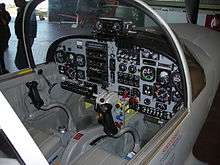
The SIAI-Marchetti SF.260 is a low-mounted cantilever wing monoplane, complete with a retractable tricycle undercarriage. It has been often praised for its sleek lines and sporty aesthetic appearance, while maintaining function as well, possessing jet-like handling as a result.[7] The construction is typically known for having a high level of worksmanship, while exterior is extensively flush-riveted to reduce drag, except for a few locations such as the flaps and some fairings.[12] The SF.260 has a compact, dense structure which possesses ballistics similar to a jet aircraft, and is approved to perform aerobatic manoeuvres.[1] In comparison to most single-engine aircraft, it possesses superior power loading and above average wing loading.[3]
The original model of the SF.260 was powered by a single Lycoming O-540 engine, capable of providing 260 hp.[3] The standard model made use of a carburetor, while fully aerobatic models featured fuel injection instead.[8] The SF.260 has been described as having the power to be immune to the gyration-like effects of turbulence and possessing a high rate of climb. During the 1980s, aerospace publication Flying Magazine stated the SF.260 to be: "the fastest normally aspirated piston single in production".[3] The SF.260 holds the airspeed records for aircraft in its class over the 100 km (62 mi) and 1,000 km (620 mi) closed circuits. Later-built models often made use of turboprop engines; the initial model to be equipped as such, designated as the SF.260TP, was powered by a single Allison Model 250 engine, flat-rated at 350 shp.[9]
The pilot and up to two passengers (or pilot and one student in trainer versions) are accommodated under a broad, extensively glazed canopy.[1] The pilot, who accesses the aircraft via purpose-built walkways along the wing, would be typically seated on the right-hand side of the cockpit; military pilots are trained to control the aircraft using their right hand on the stick and their left on the throttle.[13]
While being a fully aerobatic aircraft, it possesses favourable handling qualities, including relatively tame stall characteristics. Controllability during stalls is augmented by vanes located on the wing tip tanks which accelerate airflow over the tips and ailerons.[8] The SF.260 is a relatively fast aircraft, complete with responsive controls; as a product of the latter, pilots need to maintain awareness of speed dips, although ample aerodynamic warning is typically present.[14] Piston-engined and turboprop-engined SF.260 models generally share similar handling and flight performance.[15] Speed limitations on the landing gear has been highlighted as a negative attribute.[16] In order to safely perform aerobatics, the rear seat has to be unoccupied and the tip tanks must be empty of fuel prior to commencing any such manoeuvers, reducing the SF.260's flight endurance to roughly one and a half hours.[17]
Operational history
Burkina Faso
This small air force operated six Warriors with marks BF-8421 (c/n 049), BF-8424 (c/n 254), BF-8431 (c/n 116), BF-8451 (c/n 206), BF-8477 (c/n 134) and BF-8479 (c/n 136);[18] these Warriors were sold from the Philippines via Belgium in 1986, and were complemented by other four new Warriors coming directly from Italy,[18] and employed during the Agacher Strip War with Mali in 1986. These aircraft were in service with Escadrille de Chasse (EdC – Fighting Squadron) in Force Aérienne de Burkina Faso (FABF – Burkina Faso Air Force).[18]
Chad
Chad informed the United Nations that, during the conflict with Libya, it had destroyed eight Libyan Air Force SF.260WLs and captured nine others, besides destroying and capturing other equipment. As many as six former Libyan SF.260WLs may have been pressed into service with Chad's Air Force. By 1988 four SF.260Ws were identified as being in service, two of them were overhauled one year later in France.
In November 2006 Libya supplied Chad with four SF.260W aircraft, including crew, due to tensions between Chad and Sudan over the Dafur area. One newly supplied SF.260W was shot down on 28 November – its first mission in Chad – by rebel forces, killing the crew.[19]
Libya
Libya was a major customer of the SIAI Marchetti SF.260 with an order of 240 Warriors, partially to be assembled in a new plant near Tripoli. How many SF.260W's were actually delivered is unknown. Deliveries started in 1977 or 1978, but problems arose from a US embargo on avionics. Reportedly, the US-made avionics were replaced by French-made, which caused delays in delivery. In the late 1970s large numbers of SF.260's were parked on Vergiate awaiting delivery.
.jpg)
The SF.260WL was intended for use by the Air Force Academy for pilot training, but was also used for ground support of army troops during the border war with Chad. Little is known about the service life of the aircraft. The Libyan government supported friendly countries with arms, and several SF.260Ws were handed over to air forces such as Burkina Faso, Burundi, Nicaragua, Uganda and possibly others. In 1987 Chad reported to the United Nations the destruction of eight F.260s and the capture of nine others during its border war with Libya; some of these secondhand Libyan aircraft may even have found their way onto the US market.
Alenia Aermacchi refurbished twelve SF.260 primary trainers for the Libyan Air Force; the work was performed jointly by Alenia Aermacchi and Tripoli-based Libyan-Italian Advanced Technology. The work included overhaul of the airframes and systems, including propellers and engines. Work began in late 2007 and ran through 2008.
During the civil war, on May 7, 2011, this aircraft (along with a formation of pro-Gaddaffi planes) was probably involved in a successful air raid over the rebel-held fuel depots at Misrata, setting them on fire. NATO failed to intercept the flight, despite the introduction of a no-fly zone over Libya in March. At the beginning of the uprising, one aircraft was crushed under a tank during a rebel attack on Misrata air base.[20]
As of 2013, at least six airframes are still in service with the new Libyan Air Force and are involved in patrols and possibly airstrikes against smugglers in the porous and remote borders.
Nicaragua
Between four and six SF.260W's were received by the Fuerza Aérea Sandinista as support from Libya. They may have been used in the COIN role against the Contras and in the pilot training role. No further details are known. Three SF.260s surfaced in the USA on the secondhand market, a fourth is slowly being rebuilt in Guatemala. No longer in service.
Philippines

In the early 1970s, an order was placed for 48 SF.260s (32 SF.260M; 16 SF.260W). The first six were delivered in May 1973, replacing the Beech T-34A Mentor with 100th Training Wing at Fernando Air Base.[21]
The 15th Strike Wing on airbase Sangley Point received the SF.260W Warrior as an addition to the North American T-28 Trojans. They were possibly used in combat against rebel forces in the south of the Philippines. But little is known about its service life. In the early 1980s, the surviving Warriors were disarmed and transferred to the training role with 100th Training Wing.[21]
The Philippines Air Force signed with Agusta a contract for the delivery of 18 SF.260TP turboprops on 31 December 1991, replacing the SF.260M/W in the training role. The first SF.260TP was noted in country on 1 July 1993.[21]
Under "Project Layang" the Philippines Air Force plans to upgrade 18 SF.260M/W aircraft to the SF.260TP standard, by replacing the Lycoming piston engine with the Allison 250-B17D turbopropengine and newer avionics. The first upgraded SF.260 was delivered in 1996, no further details are available.[21][22]
The Philippines has finalized a deal with Alenia Aermacchi for 18 new-build SF.260F primary/basic trainers. All 18 were delivered by Aermacchi Italy which was locally assembled by Aerotech Industries Philippines by April 2011.[23]
Six Warriors were sold to Burkina Faso via Belgium in 1986.[24]
Rhodesia
Despite an arms embargo, two batches of SF.260 aircraft were delivered in 1977. Because of the embargo several buying teams were travelling the world looking for suitable equipment. Through various routes 17 SF.260C and 14 SF.260W aircraft arrived. The former to be used in the training role, while the warriors were being used for light attack duties and escort of convoys. In 1984–85 reportedly eight SF.260Ws were converted to SF.260TP standard by replacing the piston engine with a turboprop engine.
Sri Lanka

Six SF.260TPs were delivered to the Sri Lanka Air Force (SLAF) in 1985, to be used in the pilot training role, although they were later brought into the government's effort to subdue the Tamil Tigers. Two former factory demonstration aircraft were delivered in 1986 to replace lost aircraft, added by three new built aircraft in 1988. All SF.260 aircraft are based with No. 1 Flying Training Wing on the airbase SLAF Anuradhapura. The SF.260TP fleet was expanded in 1990–91 with the delivery of twelve former Myanmar SF.260Ws. The SF.260W fleet was withdrawn from use in 2001, being replaced by Chinese Nanchang PT-6 aircraft. The SF.260TP fleet was also retired a few years later.
Turkey
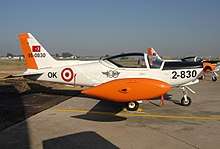
In 1990 the Turkish Air Force placed an order for 40 planes. The first six were produced in Italy and the remaining 34 were produced by Turkish Aerospace Industries in Turkey, under licence. All of the planes used in training and are deployed at the 123rd Basic Training Squadron stationed at İzmir.[25]
Zimbabwe
It was announced at the 1997 Paris Salon that the Air Force of Zimbabwe had ordered six F.260F aircraft, thus becoming the first operator of this new model. In June 1998 three F.260Fs were seen test flying at the Aermacchi homebase of Venegono. All six should have been delivered in 1998. Little is known yet about their serials and construction numbers. One of the F.260F fighter models crash landed on 4 September 2014, at a compound near Charles Prince Airport just outside Harare, killing two officers of the Airforce. The plane was on rehearsal for the 7 September Big African Airshow.
Variants
Aviamilano
- F.250 – first prototype powered by 187 kW (250 hp) Lycoming O-540-AID. The prototype, regn. I-ZUAR, was destroyed in a crash at Sestri Ponente, Genoa on 7 November 1965.[26]
- F.260 – two prototypes powered by 194 kW (260 hp) Lycoming O-540-E4A5
SIAI Marchetti
- SF.260 – Production version of the F.260
- SF.260A – Initial production version. Built in small numbers.
- SF.260M – Militarised version with strengthened airframe and improved aerodynamics
- SF.260AM – Italian Air Force version, 33 built.
- SF.260ML – Export version for Libya, 240 built.
- SF.260W Warrior – Military version with weapons hardpoints
- SF.260SW Sea Warrior – Coast patrol, fishery protection aircraft. One built.
- SF.260B – Civilian version incorporating improvements of the SF.260M. Introduced 1974
- SF.260C – Improved version of the SF.260B; introduced in 1977.
- SF.260TP – Allison 250-B17D turboprop version of the SF.260C; first flown in 1980.
- SF.260D – SF.260C with uprated engine and other refinements. Introduced in 1985
- SF.260E – Uprated SF.260D to compete for a USAF contract but later marketed to other military buyers
- SF.260F – As above, with fuel-injected engine
- SF.260EA – Most recent variant for Italian Air Force, 30 built.
Alenia Aermacchi
- SF-260 – current production model
Operators
Military operators

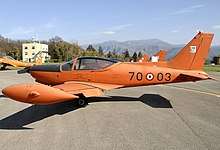
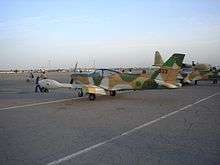
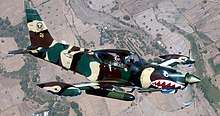

- Belgian Air Component 36 SF-260M (1969) and 9 SF-260D (1991).[27]
- Burkina Faso Air Force, 19 SF-260WL (ex Libya) and 3 SF-260W (ex Bolivia).[28]
- Burundi Air Force, 3 SF260C (1981), 1 (9?) SF-260WL (ex Libya) and 4 SF-260TP.[28]
- Chad Air Force, 9 SF-260WL (captured from Libya).[29]


- Congo Air Force, previously Zaire Air Force, 12 SF-260M (1971) amd 9 SF-260MZ (1982)
- Ethiopian Air Force, 10 SF-250TP (1984) plus another 12 delivered in 1988[30]
- Indonesian Air Force 19 SF-260M and SF.260W (2002, ex Singapore)[31]
- Italian Air Force, 45 SF-260AM (1976-2005) and 30 SF-260EA (2004) [32][33]
- Libyan Air Force, 240 SF-260WL (1977)[34]
- Mali Air Force, 1 SF-260A (2018).
- Mauritanian Air Force, 4 SF-260M (2018)[35]
- Mexican Air Force, 25 SF-260E (2019)[35]
- Philippine Air Force, 32 SF-260M amd 16 SF-260W (1972 and 1974), 18 SF-260TP (1991) and 18 SF-260FH (2008).[36]
- Tunisian Air Force, 9 SF-260C amd 12 SF-260W (1975)[37]
- Turkish Air Force, 40 SF-260D (1990).[37]
- Ugandan Air Force, 2 SF-260WL (ex Libya) and 6 SF-260M[38]
- Uruguayan Air Force, 13 T-260EU (1999)[39]
- Venezuela Air Force 12 SF-260EU (2000)[39]
- Zambian Air Force 9 SF-260M (1971-1976) and 9 SF-260TW (2018)[39]
- Air Force of Zimbabwe, 6 SF.260F (1998)[39]
Former military operators
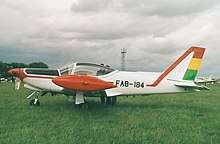

.jpg)
- Bolivian Air Force, 6 SF-260W (1978-1987)
- Royal Brunei Air Force, 2 SF-260W (1982-1998)
- Comoros Police Force Aviation, 17 SF-260C and 14 SF-260W (1977), actually re-routed to Rhodesia, plus 3 SF-260 (1978) probably never delivered.
- Haitian Air Force, 6 SF-260TP (1992)
- Irish Air Corps, 10 SF-260W (1977)
- Myanmar Air Force, 10SF260M and 11 SF-260W (1975-1990), part re-sold to Sri Lanka.
- Fuerza Aérea Sandinista, 4 to 6 SF260Wl (ex Libya)
- Rhodesian Air Force, 17 SF-260C and 14 SF-260W (1977)[40]
- Republic of Singapore Air Force – 14 SF.260Ms (1971) and 12 SF.260Ws (1979 and 1981). Part re-sold to Indonesia.[41]
- Somali Aeronautical Corps, 12 SF-260C (1979)
- Sri Lanka Air Force, 11 SF-260TP (1985-2001) amd 12 SF-260W (1991-1998, ex Myanmar)
- Royal Thai Air Force, 18 SF-260M (1973-1999)
- United Arab Emirates Air Force, 1 SF-260W (1975-1983) amd 6 SF-260TP (1983)
Civil operators
Out of about 860 SF-260s produced, around 180 have been sold to civil users. Most of these are in private hands, although at least four airlines, Alitalia, Sabena, Royal Air Maroc and British Midland Airways purchased the aircraft as a trainer for airliner pilots. Air Combat USA operates 9 SF-260s.[42]
Specifications (SF-260M)
Data from Jane's all the World's Aircraft 1988–89[43]
General characteristics
- Crew: 2
- Capacity: 1 pax
- Length: 7.1 m (23 ft 4 in)
- Wingspan: 8.35 m (27 ft 5 in) over tip-tanks
- Height: 2.41 m (7 ft 11 in)
- Wing area: 10.10 m2 (108.7 sq ft)
- Aspect ratio: 6.3:1 excluding tip-tanks
- Airfoil: root: NACA 6411-212 (modified); tip: NACA 6411-210 (modified)
- Empty weight: 755 kg (1,664 lb)
- Gross weight: 1,140 kg (2,513 lb)
- Max takeoff weight: 1,200 kg (2,646 lb)
- Fuel capacity: internal: 235 l (62 US gal; 52 imp gal) usable ; maximum (armed variants) 395 l (104 US gal; 87 imp gal) usable
- Oil capacity: 11.4 l (3.0 US gal; 2.5 imp gal)
- Powerplant: 1 × Textron Lycoming O-540-E4A5 / Textron Lycoming AEIO-540-D4A5 6-cylinder air-cooled horizontally-opposed piston engine, 190 kW (260 hp)
- Propellers: 2-bladed Hartzell HC-C2YK-1BF/8477-8R, 1.93 m (6 ft 4 in) diameter constant-speed propeller with spinner
Performance
- Maximum speed: 333 km/h (207 mph, 180 kn)
- Cruise speed: 300 km/h (190 mph, 160 kn) at 75% power at 1,500 m (4,900 ft)
- Stall speed: 137 km/h (85 mph, 74 kn) flaps and landing gear up
- 126 km/h (78 mph; 68 kn) flaps and landing gear down
- Never exceed speed: 436 km/h (271 mph, 235 kn)
- Range: 1,650 km (1,030 mi, 890 nmi) 2 crew, with maximum internal fuel including tip-tanks
- Service ceiling: 4,665 m (15,305 ft)
- g limits: +6 -3 at max aerobatic T-O weight
- +4.4 -2.2 at max utility T-O weight without external load
- Rate of climb: 7.617 m/s (1,499.4 ft/min)
- Time to altitude: 1,500 m (4,900 ft) in 4 minutes
- 2,300 m (7,500 ft) in 6 minutes 50 seconds
- 3,000 m (9,800 ft) in 10 minutes
- Wing loading: 119 kg/m2 (24 lb/sq ft)
- Power/mass: 6.19 kg/kW (10.18 lb/hp)
- Take-off run: 384 m (1,260 ft)
- Landing run: 345 m (1,132 ft)
- Take-off run to 15 m (49 ft): 606 m (1,988 ft)
- Landing run from 15 m (49 ft): 606 m (1,988 ft)
Armament
- Guns: SF-260W various pod mounted gun options
- Hardpoints: SF-260W 2 or 4 with a capacity of 300 kg (660 lb) total,with provisions to carry combinations of:
- Other: SF-260W 1 or 2 photo-reconnaissance pods
- Rockets: SF-260W various pod mounted rocket options
- Bombs: SF-260W various small bomb loads
Avionics
Typically:-
- Collins 20B VHF comm
- Collins V1R-31A VHF nav
- Collins ADF-60A
- Collins TDR-9 transponder
- Collins PN-101 compass
See also
| External video | |
|---|---|
Aircraft of comparable role, configuration and era
References
Notes
- Mondey 1981, p. 229.
- Moloda, Pino. "Italy gets the new SF260EA." Flight International, 16 August 2005.
- Moll October 1984, p. 66.
- "Leonardo SF-260". Leonardocompany.com. Archived from the original on 9 July 2016. Retrieved 4 July 2016.
- Moll October 1984, pp. 66, 73.
- Moll October 1984, p. 73.
- Moll October 1984, pp. 66–68.
- Moll October 1984, p. 68.
- Moll April 1988, p. 57.
- Moll April 1988, pp. 57–58.
- Moll April 1988, pp. 58–59.
- Moll October 1984, pp. 68–69.
- Moll October 1984, pp. 68, 70.
- Moll October 1984, pp. 70–72.
- Moll April 1988, p. 59.
- Moll October 1984, p. 72.
- Moll October 1984, p. 70.
- "Archived copy". Archived from the original on 2006-02-07. Retrieved 2013-01-18.CS1 maint: archived copy as title (link)
- "Chadian aircraft downed." Archived 2008-07-26 at the Wayback Machine Taoeil Times, 30 November 2006.
- Harro Ranter. "ASN Aircraft incident 23-FEB-2011 SIAI-Marchetti SF.260ML 5A-DME". Archived from the original on 3 November 2012. Retrieved 2 August 2015.
- "SF.260 in military service". SIAI Marchetti aircraft. Archived from the original on 30 October 2006. Retrieved 5 April 2012.
- Lewis, Paul. "Philippine air force re-engines SF.260." Flight International, 28 August 1996.
- "PAF boosts capability, ready for modernization". Philippine Information Agency. Archived from the original on 8 January 2016. Retrieved 4 April 2012.
- Cooper, Tom. "Burkina Faso and Mali, Agacher Strip War, 1985." Archived 2006-02-07 at the Wayback Machine Western & Northern Africa Database. 31 July 2004.
- "SIAI-Marchetti/TAI SF.260D". Tayyareci.com. Archived from the original on 19 February 2018. Retrieved 19 February 2018.
- "ASN Wikibase Occurrence # 31841". aviation-safety.net. Archived from the original on 1 February 2014. Retrieved 29 October 2013.
- Hoyle Flight International 11–17 December 2012, p. 46.
- Hoyle Flight International 11–17 December 2012, p. 47.
- Hoyle Flight International 11–17 December 2012, p. 48.
- Hoyle Flight International 11–17 December 2012, p. 50.
- Hoyle Flight International 11–17 December 2012, p. 52.
- Hoyle Flight International 11–17 December 2012, p. 53.
- "Il portale dell'Aeronautica Militare – SF.260EA". Archived from the original on 16 August 2016. Retrieved 17 July 2016.
- "Timeline Photos - Libyan Air Force - Facebook". Retrieved 21 November 2014.
- Hoyle Flight International 11–17 December 2012, p. 55.
- Hoyle Flight International 11–17 December 2012, p. 58.
- Hoyle Flight International 11–17 December 2012, p. 61.
- Hoyle Flight International 11–17 December 2012, p. 62.
- Hoyle Flight International 11–17 December 2012, p. 64.
- Moorcraft, Paul L.; McLaughlin, Peter (April 2008) [1982]. The Rhodesian War: A Military History. Barnsley: Pen and Sword Books. ISBN 978-1-84415-694-8.
- "SF.260 in military service". www.siai-marchetti.nl. Archived from the original on 16 June 2010. Retrieved 2 June 2010.
- Burke, Monte."In Pictures: Mile-High Dogfight—Real Sweat, Fake Weapons." Forbes, 6 January 2009.
- Taylor, John W.R., ed. (1988). Jane's all the World's Aircraft 1988–89 (79th ed.). London: Jane's Information Group. pp. 155–156. ISBN 0 7106 0867 5.
Bibliography
- Arys, Marc and Serge van Heerthum. SIAI Marchetti, Agile Penguins in Belgian Skies, Flash Aviation, 2009. ISBN 978-9-0715-5322-6.
- Green, William. The Observer's Book of Aircraft. London. Frederick Warne & Co. Ltd., 1968.
- Hoyle, Craig. "World Air Forces Directory". Flight International, Vol. 182, No. 5370, 11–17 December 2012. pp. 40–64.
- Moll, Nigel. "SIAI-Marchetti SF.260". Flying, October 1984. Vol. 111, No. 10. ISSN 0015-4806. pp. 66–73.
- Moll, Nigel. "SIAI-Marchetti SF.260TP: Turboprop Tempo." Flying, April 1988. Vol. 115, No. 4. ISSN 0015-4806. pp. 56–60.
- Mondey, David. Encyclopedia of The World's Commercial and Private Aircraft. New York. Crescent Books, 1981. ISBN 0-517-36285-6.
External links
| Wikimedia Commons has media related to SIAI-Marchetti SF-260. |